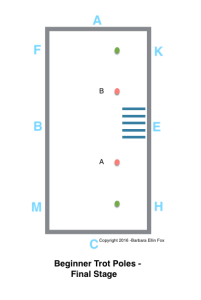3 things are required to teach beginner trot poles
- knowledge of how to use trot poles (see – Trot Poles – TheSet Up for Riding Lessons)
- a horse trained for trot poles (see – Trot Poles- Teaching the Lesson Horse)
- a lesson plan
Fear
It always surprises me to meet accomplished riders who are fearful of trot poles. It’s proof that number 1 on my list was not met in their riding path. Usually this accomplished rider barged ahead over trot poles on a green horse and it resulted in a fall.
Trot poles should be fun for the rider and interesting for the horse. Fear can be avoided with a little bit of knowledge and by following a few basic steps.
Who are Trot Poles for?
Trot poles can be used for students of dressage, saddle seat, jumping or western riding. In dressage they are used to help develop seat and feel for stride. Trot poles help saddle seat riders with timing and balance while getting the rider used to a bigger step. In jumping they are used as a precursor for actually jumping an obstacle and later they are used in gymnastic jumping. Western instructors teach students to rate pace and to navigate obstacles. Notice I have not mentioned benefits to the horse because this post on beginner trot poles is concerned with the rider.
At the very least, moving a rider on to trot poles should signify a step forward in their riding; a move to something beyond the simple basics of go, stop and turn. Reaching the stage of beginner trot poles can be viewed as an achievement. Students handle achievement or steps up in a variety of ways. Some are thrilled that the instructor has finally gotten it and isn’t holding them back any longer. (smiling) Others are nervous about a new challenge and still others prefer not to be challenged at all, even though it’s time. At any rate the beginner trot pole experience should work something important into the riding life of each student and it should never result in fear.
Teaching Trot Poles
Posting the trot over a series of five trot poles requires strong legs and a strong, working core. These are things that beginners don’t have. Normally the first time a beginner trots the five poles posting, they post well on the first pole, hands move a bit on the second, by the third pole they have gotten slightly behind the motion of the horse and by the fourth and fifth pole they are behind the motion, giving the horse a beating on his back and mouth. This happens because the rider has no idea how trot poles feel until they’ve done them.
I hate to see horses’ backs and mouths abused and this type of surprise is not what I offer my students, so I prefer to teach trot poles in two point. Two point allows the rider to stay steady, feel the rhythm and stay in sync with the horse.
Even if you don’t choose to use two point – perhaps you teach dressage, saddle seat or western riding – your students will be confident if you teach them starting with one pole and add each pole as students gain confidence and balance. I follow the same procedure laid out in Trot Poles – Teaching the Lesson Horse.
Normally I start with one pole on the rail so the fence helps guide students. I use cones to mark corners (green dots in diagram) and cones to indicate when they should be in 2 point and when they can return to posting (orange dots). If I’m teaching more than one rider, the second rider does not proceed until the first rider has passed cone A on the left rein or cone  B on the right.
B on the right.
The Goal
The goal is for students to have control over their bodies through poles in 2 point before I introduce posting trot. When I introduce posting, students hook their fingers around a neck strap to prevent hitting the horse’s mouth. They work towards being able to trot the poles with out the neck strap. When they are steady in their bodies and control the horses well, I may move the poles to the center of the arena so we can change the rein down the center line for variety.
Rarely do I need to go through the process of building from 1 pole to 5 more than once with a student because taking time and moving forward as each stage is confirmed develops confident riders. Haphazard handling of trot poles and students creates fear.
Confirming students at the elemental stage of beginner trot poles is just the start. I enjoy adding variety and challenge as lessons progress.
Trot poles are a creative tool for riding instructors. Do you have a favorite method for using beginner trot poles? I’d love to read about it in the comments.
Thanks for reading the Riding Instructor.
Barbara Ellin Fox
https://TheRidingInstructor.net
Discover more from The Riding Instructor
Subscribe to get the latest posts sent to your email.

[…] Beginner Trot Poles – Lesson Plan for teaching the […]